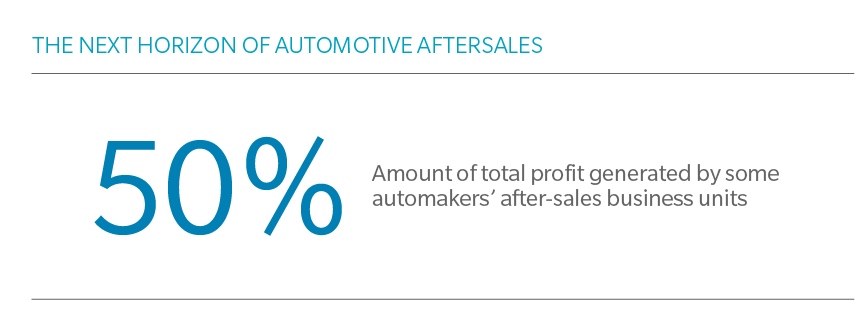For decades, the automotive after-sales business has been a tremendous success for many auto manufacturers and dealerships. Global after-sales revenue (service and parts) amounted to nearly €480 billion in 2014 and profit levels have improved consistently over the past couple of years. Market growth and profitability improvement have been driven partly by the expansion of the “auto park” in many markets but also through more sophisticated pricing of spare parts. Today, the after-sales business contributes as much as 50 percent to the overall profit of some automakers and more than 40 percent to the gross profit of large, full-range dealerships (despite accounting for only 10 percent of dealership revenue). The stability of the after-sales business also has proved vital for retail networks in times of economic uncertainty.
Challenges Ahead
Automakers have invested significantly in the after-sales businesses over the past few years, resulting in improved customer satisfaction levels and service quality. In addition, many automakers have increased their share of after-sales business with existing customers by expanding their offerings into new areas such as tire replacement. The emergence of connectivity technology will provide automakers and their service networks with another powerful hedge against independent aftermarket rivals. Despite these advantages, however, automakers and dealerships will face a number of challenges in the after-sales sector in the future, particularly:
- Advancements in vehicle quality and the focus on active warranty cost management will lead to a decline in service demand per vehicle in most markets.
- Connected vehicles will open the door for remote services, causing dealer- ships and automakers to lose part of today’s service and parts revenue.
- Customer retention at many automakers continues to decline, especially for customers with older cars, who switch more often to independent service providers in search of more affordable service.
- Existing and new intermediaries continue to steer service business away from automakers’ workshops to lower-priced independent service stations.
- Large digital players, such as Ebay, Amazon, Alibaba, and Tencent, are looking for a share of the spare parts business, likely leading to declining margins once they have accumulated enough buying power.
- Independent dealerships such as CarShop and CarSense, as well as mobile service offerings such as ClickMechanic, are providing convenient, low-cost and digital/mobile-powered offerings to customers.
In addition to the factors mentioned above, the after-sales business has failed to fulfil one of its key promises: cementing customer loyalty through superior servicing, thus ensuring the person will purchase another car from the brand. Achieving this goal was the basis for building combined sales and service outlets, in the hope that the service business would generate leads
that would benefit the new car business – but this has seldom held true.
Time For Tailored Offerings
Retailers in many industries have faced the challenges of intensified competition, revolutionary new technologies, a shrinking customer base, and increased price sensitivity. Their answer often has been to develop impressive service innovations, using IT-supported, big-data solutions to provide tailored offerings as well as differentiated branding and pricing.
The automotive industry, however, continues to deploy a one-size-fits-all solution in terms of offering, pricing, service portfolio, and branding, with dealerships often located outside of population centers and with inconvenient hours.
The Next Breakthrough
Oliver Wyman believes that true customer orientation will be the next breakthrough in the after-sales business. This will lead to a tectonic shift in the structure of the automotive business, especially on the retail end. A key component of this shift will be the separation of delivery and fulfillment networks for after-sales service. Large-scale workshops in inexpensive locations, for example, could be used to consolidate service demand for a broad customer base. Such a strategy would ensure efficient, low-cost operations, leverage scale effects and lean principles, and dramatically improve the cost position for automakers and retail partners.
These “service factories” could be fed by pickup and delivery points placed in convenient locations for the customer, such as near public transport stations or shopping malls. Such locations could be better differentiated in terms of offering and branding than what is available today. While the transportation of vehicles between delivery points and service factories would add cost for the retail partner, Oliver Wyman’s research shows that this would be offset by the cost improvement in service execution.
A New Era Of Network Planning
The investment required to restructure the after-sales service network would be substantial, but the risks associated with not making a change are likely to be much greater. With an operating margin of only two to three percent, even large, successful dealership groups have little room to absorb any shocks to their businesses. Given the challenges facing the after-sales sector as well as changes in the new and used car sales businesses, a revenue drop of just five percent or a further decline in profitability would create significant, structural problems for retail networks. If that happens, automakers will be forced to further support their dealerships to safeguard their sales and service networks. Oliver Wyman believes that now is the time to redefine the role of the different business units within the dealership and to begin a process of network planning based on disaggregation. Only then will automakers and dealers have the chance to actively manage their approach to the next horizon in the automotive after-sales business.








